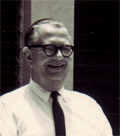During the 1940‘s and into the 1950‘s, there were three forecast offices in the region located in the Bahamas,
Jamaica and Trinidad and Tobago. These countries, at the time, were all colonial dependent territories and the
Directors and  forecasters of the meteorological services were from the United Kingdom. The meteorological
observers were from within the region.
forecasters of the meteorological services were from the United Kingdom. The meteorological
observers were from within the region.
The three forecast offices and the Meteorological Services in the other islands were linked together under the umbrella of the West Indies Meteorological Service (WIMS), with its headquarters located in Trinidad and Tobago. The Director of the WIMS was Mr. W. A. Grinstead and his Deputy was Mr. K.V.W. Nicholls, both from the U.K.
The West Indies Meteorological Service was superseded by the Caribbean Meteorological Service which was established on January 1st 1963, with Mr. Nicholls as the Director-General. The participating territories in this Service were:

The Bahamas withdrew from the CMS on January 1st, 1964.
The Caribbean Meteorological Organization (CMO) is a functionally autonomous agency within the CARICOM family. It originated out of the old British Caribbean Meteorological Service, which was established in 1951. This Service later became the Caribbean Meteorological Service after the break up of the West Indian Federation. The Caribbean Meteorological Services established the Caribbean Meteorological Institute (CMI) in 1967. But with the establishment of many National Meteorological Services after independence, the Caribbean Meteorological Service was subsequently transformed into the CMO in 1973, so that the joint activities could continue.